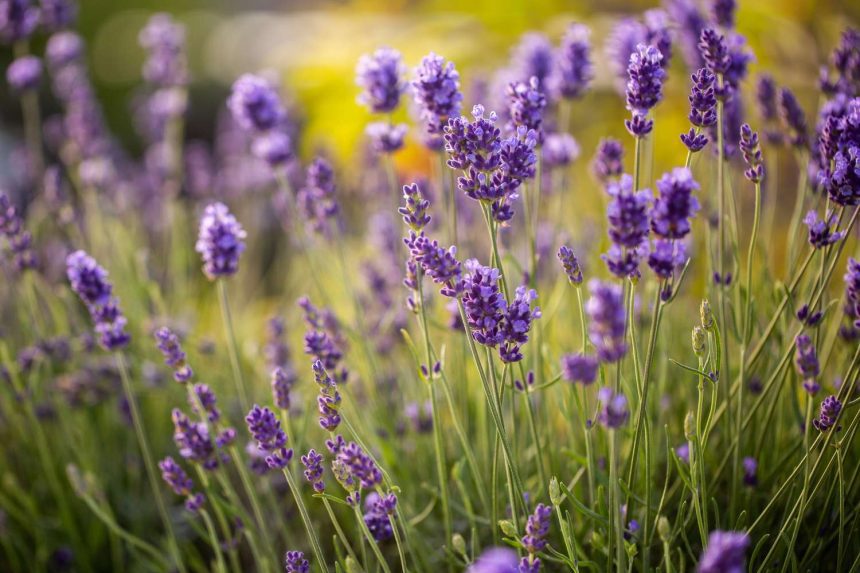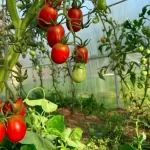Lavender is a beautiful and fragrant plant that many people love to grow in their gardens. But did you know that lavender can grow even better when planted with the right companion plants? In this introduction, I’ll explore the best plants to grow alongside lavender. These companion plants not only make your garden look more attractive but also help lavender thrive. By choosing the right plants to pair with lavender, you can create a garden that is healthier, more colorful, and more environmentally friendly. Discovering these ideal companion plants will make gardening more enjoyable and satisfying for you.
Understanding Lavender
Lavender, a symbol of serenity and grace, thrives in gardens with it’s captivating fragrance and beautiful purple hues. Belonging to the mint family, it favors sunny spots and well-drained soil, showcasing resilience and low maintenance. This hardy perennial not only adorns landscapes but also offers therapeutic benefits, making it a cherished choice for gardeners. It’s versatility and ease of care make it an ideal plant for both novice and experienced gardeners alike.
Benefits of Companion Planting
Biodiversity and Balanced Ecosystems
The most important benefit of companion planting is that it adds variety to your garden. By planting different kinds of plants together, you create a balanced garden. This variety helps keep pests and diseases away. Different plants attract good bugs and pollinators, which are important for a healthy garden. For example, some flowers might attract ladybugs that eat aphids, while others might attract bees for pollination, which leads to a better harvest..
Sharing Nutrients and Healthy Soil
Companion planting also helps plants share nutrients in a natural way. Some plant pairs work well together and benefit from growing next to each other. For example, legumes (like peas and beans) add nitrogen to the soil, which is good for plants growing nearby that need a lot of nitrogen. This natural nutrient sharing means you don’t need to use as much chemical fertilizer, making your garden more organic and earth-friendly.
Keeping Pests Away Naturally
Another good thing about companion planting is that it can keep pests away naturally. Many plants give off certain smells or substances that pests don’t like, protecting the plants around them. For instance, marigolds release things that keep tiny worms called nematodes away, helping to protect nearby plants. This natural way of controlling pests means you don’t need to use as many harmful pesticides, making your garden healthier and better for the environment.
Garden Space and Providing Shade
Companion planting also helps you use your garden space wisely. You can arrange plants with different root depths and growth habits to make the most of your space. Tall plants can give shade to shorter plants that like shade, while ground covers can stop weeds from growing and help keep the soil moist. This creates a garden that works well together and looks nice.
Garden Look Pretty
Lastly, companion planting makes your garden look really pretty. Combining different colors, textures, and plant shapes creates a beautiful landscape. This not only makes your garden a great place to grow things but also a lovely place to look at, making gardening fun and enjoyable.
Best Companion Plants for Lavender
Certain plants, when grown alongside lavender, can enhance it’s growth and health. We’ll explore these companions in detail.
Herbs as Companion Plants
Herbs like rosemary, thyme and sage share similar growing conditions with lavender, making them ideal companions.
Rosemary
Rosemary is a strong-smelling herb that grows well in sunny places with good drainage. It has thin leaves that look like needles and a unique smell. This tough plant not only makes food taste better but also keeps bad bugs away. It’s easy to take care of and doesn’t need a lot of water, making it a great choice for any garden. Rosemary brings a touch of the Mediterranean and a feeling of strength to your garden.
Thyme
Thyme is a useful and nice-smelling herb with small, fragrant leaves. It does well in sunny, dry places and is easy to take care of. This tasty herb also works well as a ground cover, making your garden look pretty and bringing in good bugs.
Sage
Sage has soft, gray-green leaves that smell really good. It’s a favorite in both cooking and decorative gardens. Sage grows well in full sun and soil that drains well. It’s known for its strong flavor and its ability to keep common garden pests away, making it a valuable and pretty addition to any garden.
Flowers and Ornamentals
Flowers like echinacea, yarrow, and sedum not only make lavender look even prettier but also help create a healthy garden.
Echinacea
Echinacea, also known as coneflower, is a bright and tough flower that adds lots of color to gardens. It does well in full sun and soil that drains nicely, and it’s easy to take care of. Echinacea is known for its healing properties and its pretty, daisy-like flowers. It not only makes gardens look beautiful but also brings in good pollinators like bees and butterflies, helping to create a healthy, thriving, and nature-friendly garden.
Yarrow
Yarrow has feathery leaves and bunches of small, bright flowers. It’s a strong and adaptable plant that’s great for any garden. It grows well in soil that drains well and in full sun, and it’s known for being tough and easy to care for. This lovely plant not only adds a pop of color but also attracts good bugs and helps nearby plants by making the soil better. It’s a valuable and charming choice for gardeners who want both beauty and usefulness.
Sedum
Sedum is a group of succulent plants that come in many varieties. They’re known for being tough and looking striking. These low-maintenance plants do well in well-drained soil and full sun, making them perfect for different types of gardens. With their thick leaves and star-shaped flowers, sedums add interesting textures and colors to the landscape. They don’t need a lot of water, attract pollinators, and fit in well with other plants, making them a valuable and eye-catching choice for any garden lover.
Vegetables and Fruits
| Vegetable/Fruit | Description | Benefits as Companion to Lavender |
|---|---|---|
| Tomatoes | A popular garden staple, thriving in sunny conditions and well-drained soil. | Lavender’s scent repels pests that commonly affect tomatoes. |
| Cabbage | Leafy green requiring full sun and fertile soil. | The aroma of lavender helps deter cabbage moths and other pests. |
| Carrots | Root vegetable favoring well-drained soil and full sun. | Lavender can help repel carrot flies and enhance carrot flavor. |
| Strawberries | Sweet, sun-loving berries that prefer well-drained soil. | Lavender protects strawberries from some pests and enhances growth. |
| Grapes | Vine fruit that enjoys sunny spots and well-drained soil. | Lavender aids in repelling pests and can improve the overall health of grapevines. |
| Peppers | Thrive in warm, sunny conditions with well-drained soil. | The strong scent of lavender helps in keeping away common pepper pests. |
| Potatoes | Starchy tubers growing best in full sun and well-drained soil. | Lavender can deter pests and improve the surrounding soil structure. |
| Beans | Versatile legumes that prefer sunny spots and moderate watering. | Lavender helps in repelling pests that commonly affect bean plants. |
| Onions | Bulb vegetables that grow well in full sun and loose, fertile soil. | Lavender’s strong scent can deter common onion pests. |
| Spinach | Leafy green that enjoys cool temperatures and well-drained soil. | Lavender can provide partial shade and protect spinach from pests. |
Avoiding Incompatible Plants
- Ferns: Prefer shady and moist conditions, which contrasts sharply with lavender’s love for sun and well-drained soil.
- Hostas: These shade-loving plants require more water and less sun than lavender, making them unsuitable companions.
- Impatiens: Thriving in moist and shaded environments, impatiens’ requirements clash with the dry and sunny conditions favored by lavender.
- Rhododendrons and Azaleas: Acid-loving plants that require more water and shade, not compatible with lavender’s needs.
- Bamboo: It’s aggressive growth and preference for moist conditions can overpower and out-compete lavender.
- Hydrangeas: These plants prefer more acidic and moist soil, which doesn’t align with lavender’s preference for alkaline, dry conditions.
- Willows: Known for their need for significant amounts of water, willows can monopolize moisture, leaving lavender deprived.
- Mint: Although an herb, mint’s aggressive growth and need for more moisture can overwhelm lavender.
- Lawn Grasses: They require more frequent watering and can encroach on the space and nutrients needed by lavender.
- Cucumbers: Tend to require more water and can create a more humid environment than lavender prefers.
Designing a Companion Garden
The first step is to understand the relationships between different plants. Some plants, like lavender and rosemary, thrive together, sharing similar needs for sunlight and well-drained soil. Others, like lavender and ferns, have contrasting requirements and should be avoided.
Plan for Sunlight and Water Needs:
Group plants with similar sunlight and water needs. Lavender, for instance, loves full sun and less frequent watering, so it should be paired with plants that thrive under these conditions.
Consider Growth Patterns and Space
Account for the height, spread and root systems of your plants. Tall plants can provide shade for smaller, shade-tolerant species, while deep-rooted plants can coexist with shallow-rooted ones without competing for nutrients.
Attract Beneficial Insects and Pollinators
Incorporate plants that attract beneficial insects and pollinators. Lavender attracts bees and butterflies, enhancing pollination for the entire garden.
Rotate Crops Annually
If you’re including vegetables in your companion garden, practice crop rotation to prevent soil depletion and reduce disease and pest buildup.
Utilize Natural Pest Control
Choose plant combinations that naturally repel pests. For example, marigolds can deter nematodes and other pests from sensitive vegetables.
Create Visual Harmony
Balance the colors, textures and forms of plants for a visually pleasing garden. Consider bloom times to ensure a continuous display of flowers.
Leave Room for Growth and Maintenance
Ensure there’s enough space between plants for growth and maintenance activities like pruning and weeding.
Maintenance Tips
| Maintenance Aspect | Tips and Best Practices |
|---|---|
| Watering | Lavender prefers less frequent, deep watering. Ensure adequate drainage to prevent root rot. Companion plants should also have similar watering needs. |
| Soil Health | Use well-draining soil, ideally slightly alkaline for lavender. Add organic matter annually to maintain soil fertility. |
| Pruning | Regularly prune lavender to encourage bushy growth and prevent woody stems. Prune companion plants as needed to maintain shape and health. |
| Fertilizing | Lavender generally requires little fertilizer. Use a balanced, slow-release fertilizer for other garden plants, avoiding high nitrogen content which can reduce lavender’s fragrance. |
| Weeding | Keep the garden free of weeds to reduce competition for nutrients and water. Mulching can help suppress weed growth. |
| Pest Control | Inspect plants regularly for pests. Use natural remedies like neem oil or introduce beneficial insects, as lavender naturally repels many pests. |
| Disease Prevention | Ensure good air circulation around lavender to prevent fungal diseases. Rotate crops if growing vegetables to minimize disease risk. |
| Mulching | Mulch to retain soil moisture and temperature. Use organic mulch like straw or bark, but avoid mulching too close to lavender stems. |
| Winter Care | Protect lavender and sensitive companions with mulch or coverings in harsh winters. Some plants may need to be brought indoors or provided with extra insulation. |
| Harvesting | Harvest lavender at peak bloom for maximum fragrance. Harvest companion plants as per their specific harvesting guidelines. |
Pest and Disease Management
To keep your garden with lavender and its companion plants healthy, it’s important to prevent pests and diseases. Check your plants often for signs of problems. Lavender naturally keeps many pests away with its strong smell. Encourage good bugs like ladybugs and bees to help control pests in a natural way. To prevent diseases, make sure air can move around the plants and don’t water too much, since lavender likes well-drained soil. Using these natural methods keeps your garden healthy and earth-friendly.
Seasonal Care
Seasonal care for your garden, especially when nurturing lavender and it’s companions, involves adapting to the changing needs of your plants throughout the year.
- Spring: As plants start to grow, gently prune lavender to help it grow new leaves. Plant or move companion plants when the soil gets warm. Add compost to make the soil richer.
- Summer: Plants grow and bloom the most. Water deeply but not too often during dry times. Watch for pests and diseases, especially when it’s humid.
- Fall: As plants grow slower, water less. Harvest lavender and get your garden ready for cold weather. Put mulch around plants to protect their roots from freezing.
- Winter: Lavender and many of its companions are tough, but some might need extra protection from very cold weather and frost. Cover plants with mulch or burlap to keep them warm. Let your garden rest and plan for next season
Harvesting and Usage
Harvesting
Picking lavender and its companion plants from your garden is a fun and rewarding experience. Pick lavender when the buds are just starting to open, usually late in the morning after the dew dries. This is when the lavender will smell the best and be the most useful. For herbs like rosemary and thyme, pick them before they flower for the best taste. Pick vegetables and fruits when they are ripe for the freshest taste and the most nutrition.
Usage
You can use the things you pick from your garden in many ways. Lavender smells nice and can be used in sachets, essential oils, or added to food for a flowery taste. Herbs like sage and basil make many recipes taste better, from main dishes to drinks. Vegetables and fruits from your garden are perfect for healthy meals. Some plants, like echinacea, can also be used to make teas or medicines. The food from your garden not only feeds you but also connects you to nature, making your life better with its smells, tastes, and healing powers.
Environmental Impact
A garden with lavender and companion plants is really good for the environment. It helps more kinds of plants and animals live together by bringing in good bugs and pollinators, which are important for a healthy ecosystem. This means you don’t need to use as many chemical pesticides, letting nature find its own balance. Having different kinds of plants also helps make the soil healthier and stops it from washing away. These gardens not only make everything look prettier but also help nature in your local area, making a small but important safe place for plants and animals.
Conclusion
Planting lavender with companion plants leads to a beautiful, healthy, and earth-friendly garden. This way of gardening helps lavender and its plant friends grow better and stay healthy. It also makes your garden look amazing and helps the environment. By bringing in good bugs, making the soil better, and keeping pests away naturally, planting lavender with other plants shows how pretty and balanced nature can be. It’s a fun and rewarding experience for any gardener, from beginners to experts. It lets you connect with nature and enjoy all the good things your own little piece of nature has to offer.
FAQs
Herbs like rosemary, thyme and sage are excellent companions for lavender, as they share similar growing conditions. Flowers such as echinacea and yarrow also pair well, enhancing the garden’s aesthetic and ecological balance.
Lavender prefers less frequent, deep watering. Ensure the soil is well-drained and allow it to dry out slightly between waterings.
Yes, lavender is known for it’s natural pest repellent properties, particularly against moths, beetles and fleas, making it a beneficial addition to any garden.
Absolutely! Lavender is relatively low maintenance, thriving in well-drained soil and full sun, making it a great choice for beginners.
Yes, lavender can be used in culinary dishes for a floral flavor and is also known for it’s calming and medicinal properties, often used in aromatherapy and homemade remedies.




